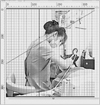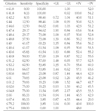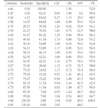Abstract
Objectives
Work-related musculoskeletal disorder (WMSD) of the neck is a frequent health problem in dental hygienists. This study was conducted to assess the risk factors of neck musculoskeletal disorder (neck MSD) using video recording.
Methods
The subjects were 50 currently working dental hygienists who agreed to participate in this study. A standardized questionnaire about WMSD (NIOSH/KOSHA) was distributed and video recording for neck posture and motion was performed between August and October 2012. The video recording was performed for 5 minutes using the reflective marker attachment on the 7th cervical vertebra. Major observation points included neck flexion angle, number of flexions, and length of static work when performing scaling and prosthetic procedures. Data were analyzed using MedCalc (ver 12.3.0, Mariakerke, Belgium), and the risk factors for neck MSD were assessed using simple and multiple variate analysis.
Results
The mean age and work experience of the subjects were 27.9 years and 5 years respectively. The prevalence of neck MSD symptoms that met NIOSH/KOSHA's criteria was 48%. The mean angle of neck flexion was 54.6°, mean maximum angle of flexion was 64.8°, and the mean time of static posture was 4.8 minutes during the 5 minutes recording interval. In the multiple logistic regression analysis adjusted by career, daily work time, and posture, the prevalence of neck MSD symptoms increased by 1.47 times (95% CI=0.24–9.48) with flexion >45°, and by 4.90 times (95% CI=0.91–26.4) when a static posture was preserved for >4.8 minutes
Conclusions
The measured angle of flexion and time of preserved static posture identified further serious than expected. Therefore, to reduce the risk of neck MSD, reasonable and practically applicable guidelines to correct neck bending and tilting, especially to relax the long static posture associated with flexion, should be prepared.
Figures and Tables
Fig. 3
ROC curve of average neck flexion angle whether neck musculoskeletal disorder symptom. Area under curve(AUC)=0.530, Associated criterion≤53.4.

Fig. 4
ROC curve of maximum neck flexion angle whether neck musculoskeletal disorder symptom. Area under curve(AUC)=0.530, Associated criterion≤59.

Fig. 5
ROC curve of length of static work for 5 minutes whether neck musculoskeletal disorder symptom. Area under curve(AUC)=0.540, Associated criterion≤4.8.

Table 2
Neck flexion angle, number of flexion, and length of static work when scaling and prosthetic procedure (for 5 minutes)

References
1. Oberg T. Ergonomic evaluation and construction of a reference workplace in dental hygiene: a case study. J Dent Hyg. 1993; 67:262–267.
2. Lee HI, Lee DC. An Ergonomic Analysis of Dental Clinic Activities Using 2 Dimensional Motion Analyser. J Korean Inst Plant Eng. 1999; 4:127–137.
4. U.S.Department of Labor. Ergonomics Enforcement & Inspections. cited 2013 Mar 01. Available from: http://.leg.wa.gov/WAC/“OSHAErgonomics. WAC296-62-051.
5. Eriksen W, Natvig B, Knardahl S, Bruusgaard D. Job characteristics as predictors of neck pain. A 4-year prospective study. J Occup Environ Med. 1999; 41:893–902.
6. Kilbom A. Repetitve work of the upper extremities; Part I-Guidelines for the practitioner, Part II-The scientific basis (knowledge base) for the guide. Int J Ind Ergon. 1994; 14:51–86.
7. Morse T, Bruneau H, Michalak-Turcotte C, Sanders M, Warren N, Dussetschleger J, Diva U, Croteau M, Cherniack M. Musculoskeletal disorders of the neck and shoulder in dental hygienists and dental hygiene students. J Dent Hyg. 2007; 81:10.
8. Smith CA, Sommerich CM, Mirka GA, George MC. An investigation of ergonomic interventions in dental hygiene work. Appl Ergon. 2002; 33:175–184.

9. Marklin RW, Cherney K. Working postures of dentists and dental hygienists. J Calif Dent Assoc. 2005; 33:133–136.
10. Jonker D, Rolander B, Balogh I. Relation between perceived and measured workload obtained by long-term inclinometry among dentists. Appl Ergon. 2009; 40:309–315.

11. Anton D, Rosecrance J, Merlino L, Cook T. Prevalence of musculoskeletal symptoms and carpal tunnel syndrome among dental hygienists. Am J Ind Med. 2002; 42:248–257.

12. Morse T, Bruneau H, Dussetschleger J. Musculoskeletal disorders of the neck and shoulder in the dental professions. Work. 2010; 35:419–429.

13. Hayes MJ, Smith DR, Cockrell D. Prevalence and correlates of musculoskeletal disorders among Australian dental hygiene students. Int J Dent Hyg. 2009; 7:176–181.

14. Kim DS, Bae SD, Mun MG, Kim CH, et al. Criteria for classification of flexion angle for the assessments of posture by observation methods. J Ergon Soc Korea. 2007; 126–131.
15. Kilbom A, Persson J, Jonsson BG. disorders of the cervicobrachial region among female workers in the electronics industry. Ergonomics. 1986; 1:37–47.

16. Choi MG, Choi SB, Cha SE. A Survey on the Subjective Symptoms and Risk Factors of Musculoskeletal Disorders in Dentists. J Korean Soc Saf. 2006; 21:106–115.
17. Kim JH, Kim HJ. A Study on the Musculoskeletal Pain Experience of Dental Hygienist's Treatment Postur. J Dent Hyg Sci. 2009; 9:413–418.
18. Park SR, Shim YS, Jung SH. Original Article : Dental hygienists work-related musculoskeletal symptoms and factor analysis. J Korean Soc Dent Hyg. 2012; 12:685–693.

19. Yu JH, Jeong SC. A Study of the Musculoskeletal Disorders Among Dentists. J Korean Acad Craniomandib Disord. 1994; 6:103–115.
20. Chaffin DB. Localized muscle fatigue-definiton and measurement. J Occup Med. 1973; 15:346–354.
21. Horton SJ, Johnstone CL, Hutchinson CM, Taylor PA, Wade KJ. Clinical working postures of bachelor of oral health students. N Z Dent J. 2011; 107:74–78.
22. Taboun SM. Cumulative Trauma Disorders: An Ergonomic Intervention. Adv Ind Ergon Saf. 1990; 277–284.
23. Hagberg M. Electromyographic signs of shoulder muscular fatigue in two elevated arm positions. Am J Phys Med. 1981; 60:111–121.




 PDF
PDF ePub
ePub Citation
Citation Print
Print









 XML Download
XML Download